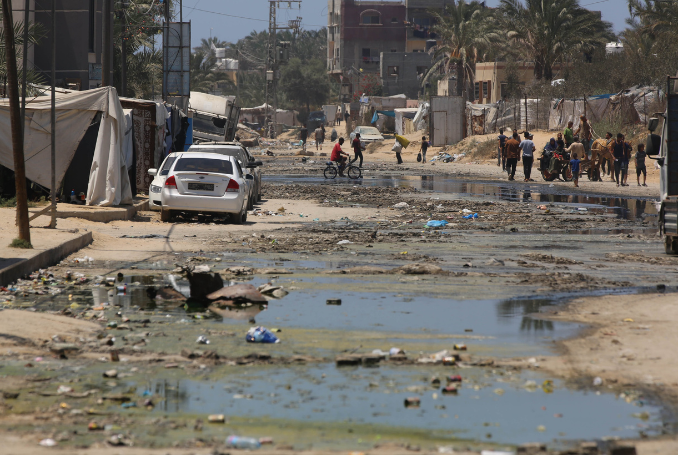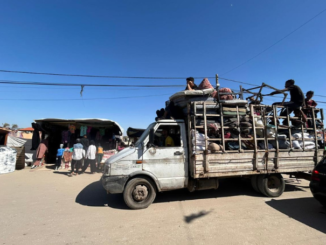
On July 30, Gaza’s Health Ministry said the polio-causing virus type CVPV2 was discovered “in the sewage water in Khan Younis and the central governorates.”
Warnings of an imminent polio outbreak in Gaza are growing as Israel continues its deadly assault on the Gaza Strip in addition to an ever-deteriorating humanitarian aid supply.
“We’re expecting a polio outbreak in the next number of days or weeks,” Francis Hughes, Gaza Emergency Response Director for global humanitarian agency, CARE International, told the Anadolu news agency.
On July 30, Gaza’s Health Ministry said “the polio-causing virus type CVPV2” has been discovered “in the sewage water in Khan Younis and the central governorates.”
After many years “of eradicating polio,” the population faced a “dire situation” caused by Israel’s military offensive in Gaza, the Ministry said, “which has deprived residents of safe drinking water, destroyed sewage infrastructure, accumulated thousands of tons of garbage, caused food insecurity, and crowded residents in forced displacement areas.”
The discovery, it said, “poses a health threat to the residents of the Gaza Strip and neighboring countries and is a setback for the global polio eradication program.”
‘Missing the Signs’
The situation has triggered fears of a resurgence of the disease eradicated from the region over 25 years ago.
Hughes, who is currently in Gaza, said aid workers “could be missing the signs” of the disease.
“Our doctors and nurses have not been trained on how to identify the signs and symptoms of polio,” he said. “There’s a strong possibility they have come to our clinic, but we haven’t necessarily identified them yet.”
Hughes said the situation in Gaza is one of the worst humanitarian disasters he has seen, with the deplorable health and hygiene conditions exacerbating the threat of polio and other infectious diseases.
Treatment Plants Destroyed
He said most of Gaza’s infrastructure has been completely destroyed in Israel’s ongoing offensive, which has now killed nearly 40,000 Palestinians and wounded almost 92,000.
This includes water and sewage treatment plants, as well as basic water supply infrastructure, such as pipes, he said, while access to water trucks is also gone as Israel is not letting in any fuel.
People throughout Gaza are forced to drink contaminated water and seawater, and “we have no way to test it either,” he said.
“When you drive through Gaza … there’s sewage everywhere,” said Hughes, warning that the situation will only get worse in the winter months when rains start.
Vaccine Challenge
The World Health Organisation (WHO) said last month that the vaccine-derived poliovirus type 2 (VDPV2) was found” at six locations in sewage samples collected on 23 June from Gaza’s Khan Yunis and Deir Al-Balah areas.
Hughes pointed out that, even if Israel is somehow made to let in vaccines and other critical supplies, there would still be massive hurdles to overcome.
“Once they (vaccines) get into Gaza, we need to roll out a vaccination campaign, but to do that in the current situation is almost impossible,” he said.
Before any sort of vaccination campaign, there has to be “a lot of training for doctors and nurses” and everything is severely complicated as access to hospitals is very difficult, especially in the north of Gaza, he said.
“We’re at a point now where it’s almost inevitable that there would be an outbreak,” warned Hughes.
He said even aid workers “have been asked to quarantine for two weeks before they come into Gaza, if they come from a polio country.”
“This is putting more pressure on aid workers as we work all over the world and are coming to Gaza from different corners of the globe,” he said.
Lack of Testing Facilities
WHO spokesperson, Tarik Jasarevic, reportedly said the agency “considers there to be a high risk of spread of this strain within Gaza, and internationally, particularly given the impact the current situation continues to have on public health services.”
No clinical cases have been confirmed in Gaza, so far, but that is primarily due to a lack of surveillance and testing facilities.
“Acute flaccid paralysis (AFP) surveillance has not been functioning adequately, and surveillance has been suspended since 7 October last year,” said Jasarevic.
As for immunization, he said vaccination rates in Occupied Palestinian Territories were “optimal” before the war, with routine coverage at 95 percent and above in 2022.
Decimation of Health System
In 2023, polio vaccination coverage, primarily conducted through routine immunization, was estimated at 89 percent, according to the latest WHO-UNICEF routine immunization estimates.
“In the past nine months, routine vaccination has been disrupted and tens of thousands of children under 5 years old are at risk of contracting polio and other vaccine-preventable diseases,” said the spokesperson.
More than 90 percent coverage needs to be achieved to ensure cessation of an outbreak and mitigate the risk of re-emergence, according to the WHO.
“The decimation of the health system, lack of security, access obstruction, constant population displacement, shortages of medical supplies, poor quality of water and weakened sanitation … creates the perfect environment for diseases like polio to spread,” the spokesperson said.
(Anadolu, PC)







